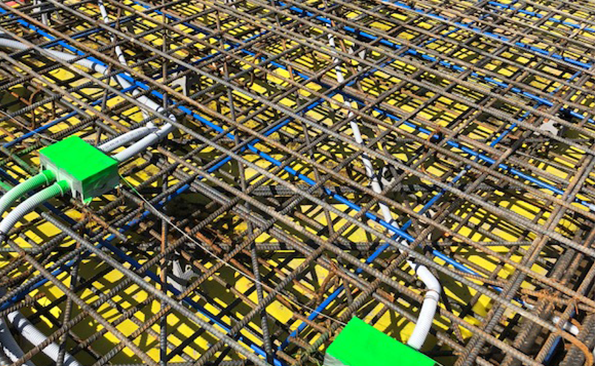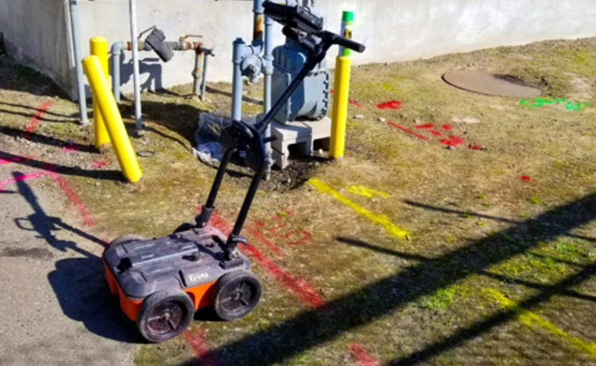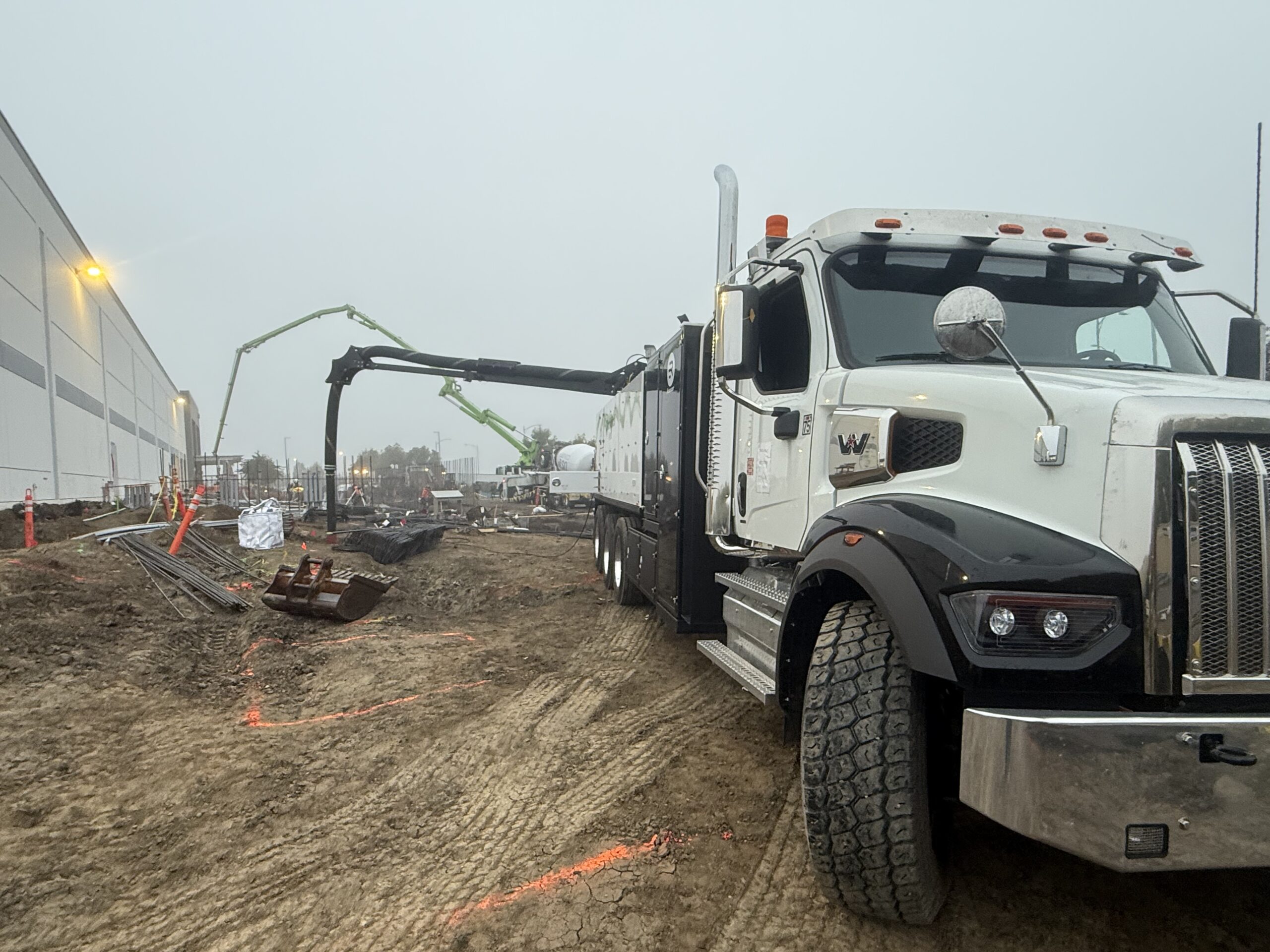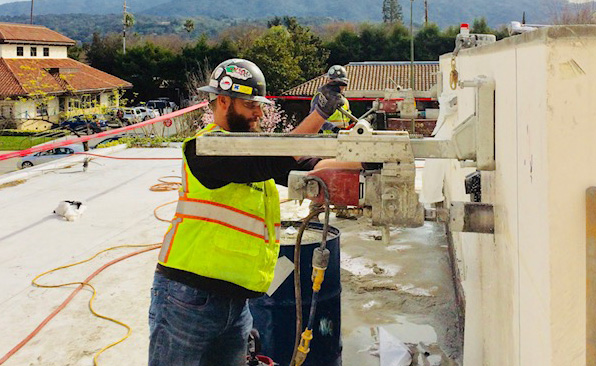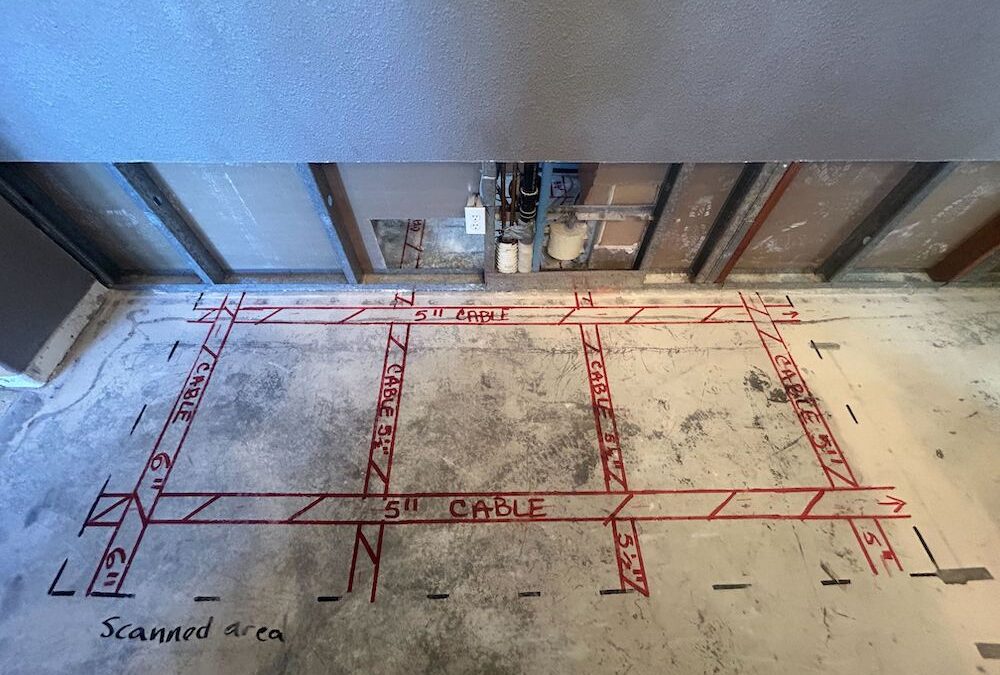Summary: Before any concrete is drilled, cut, or cored, scanning the slab is essential to avoid hitting rebar, electrical lines, or buried pipes. Concrete scanning services like ours use ground-penetrating radar and X-ray technology to detect embedded hazards and prevent costly damage or injury. Learn why scanning is critical for safety, compliance, and project success.
Concrete slabs aren’t just solid blocks of grey. Hidden within are complex networks of rebar, post-tension cables, electrical conduits, water pipes, and even telecom cabling. These components aren’t randomly placed-they’re integral to the performance and functionality of modern structures.
Drilling or cutting into concrete without identifying these buried elements leads to immediate and expensive consequences. Severed conduits mean damaged power systems or data infrastructure. Pierced water or gas pipes result in leaks, shutdowns, and potential safety hazards. Striking rebar can compromise load-bearing strength and trigger structural failures that require costly remediation.
Concrete scanning identifies what lies below the surface with high precision. This non-destructive process maps embedded components in real time, allowing crews to avoid them with confidence. By preserving reinforcing steel and internal systems, the integrity of the slab remains intact-and so does the project timeline.
Concrete Scanning: The First Line of Defense for Site Safety
Preventing On-Site Injuries Through Subsurface Detection
Every time a drill pierces into concrete without prior scanning, the risk of striking rebar, post-tension cables, or live electrical conduit escalates. A single error can turn into a life-altering event-electric shocks, structural collapses, or tool kickbacks aren’t hypothetical risks; they’re documented outcomes.
Concrete scanning eliminates those blind spots. Ground-penetrating radar (GPR) and embedded sensor mapping help operators detect hidden dangers in real-time. The data guides precise cut lines and drilling points, ensuring no worker unknowingly compromises the site’s safety. Fewer surprises under the slab means no accidental contact with energized elements or stressed structural components.
According to the U.S. Bureau of Labor Statistics, in 2022 alone, construction sites saw over 17,000 injuries related to contact with objects and equipment. Intersections of concrete work and utility or cable misidentification regularly feature in this category. By proactively mapping out what lies beneath the surface, teams virtually eliminate such risk vectors before a core bit makes contact.
Q: What is concrete scanning?
A: Concrete scanning is a non-destructive method used to detect embedded objects like rebar, electrical conduit, and post-tension cables in concrete before drilling or cutting.
Meeting Safety Compliance Through Pre-Scan Protocols
Occupational safety compliance isn’t a suggestion-it’s enforceable. Agencies such as OSHA hold contractors accountable for due diligence during demolition and retrofitting. Concrete scanning meets multiple regulatory requirements outlined in standards like OSHA 1926 Subpart K (Electrical Safety) and 1926 Subpart Q (Concrete and Masonry Construction).
Workplaces adopting scanning technologies aren’t just reducing risk-they’re demonstrating compliance with federal and regional codes. In environments where a missed utility strike could lead to shutdowns, fines, or criminal charges, scanning becomes an operational safeguard, not just an optional expense.
- Live electrical conduits-detecting them with GPR avoids electrocution and system outages.
- Post-tension cables-cutting a tensioned cable can cause structural destabilization and immediate injury.
- Embedded gas or water lines-accidental punctures trigger hazardous leaks and catastrophic disruptions.
Integrating scanning into standard operating procedure isn’t just about avoiding incidents. It reflects a company’s control over its environment, a mandate echoed by client audits and insurance inspections alike. For any drilling or coring job, safety starts with certainty-and that certainty starts with seeing the unseen inside the concrete.
Risk Mitigation and Cost Savings: A Strategic Advantage of Concrete Scanning
Integrating concrete scanning into construction workflows reduces uncertainty and prevents high-cost disruptions. No project manager plans to strike post-tension cables or sever a conduit, yet those accidents happen frequently when scanning is omitted. Each cutting or drilling decision, when made without data, compounds risk-financially and structurally.
How Early Detection Translates Into Real Savings
Every embedded object detected before a cut eliminates a potential repair. For example, hitting a live power conduit can result in immediate work stoppage, damage to equipment, and electrical hazards requiring emergency remediation. In commercial settings, such incidents also incur costs tied to lost operational time and contractual penalties.
According to industry data from Concrete Sawing & Drilling Association (CSDA), scanning before coring and cutting can reduce unplanned repair costs by up to 80%. Compare that to the average $2,000-$5,000 expense for repairing severed rebar or data cabling. Multiply that risk across multiple cores or cuts, and early detection becomes a financially decisive practice.
Avoiding Unexpected Project Delays
Unexpected obstructions trigger delay chains. First, there’s the immediate halt in work. Then, teams reroute their plan. Engineers get involved. Procurement of new materials may follow. This cascade erodes project schedules and creates compliance issues when timelines are contractually bound.
- Timeline protection: Scanning enables high-confidence scheduling by revealing conflicts before crews disengage existing systems.
- Budget adherence: Additional labor, remediation, and re-engineering costs are virtually eliminated when damage is avoided upfront.
- Minimized downtime: Facilities that operate during construction, such as hospitals or data centers, avoid costly operational disruptions due to accidental hits.
Concrete scanning transforms unknowns into knowns. The cost of a scan becomes negligible when compared against the quantified savings in materials, labor, and time. Without it, every drill bit break or unmarked cable strike eats into margins-and invites reputational risks no team can afford.
Inside the Process: How Concrete Scanning Works
Concrete scanning uses advanced detection technologies to identify what lies beneath the surface of a concrete slab or wall. This process reveals the precise location of embedded elements such as rebar, post-tension cables, electrical conduits, and voids before any drilling or cutting begins. Accuracy hinges on the technology applied and the technician’s skill in interpreting scan data.
From Surface to Structure: The Basic Workflow
The scanning process begins with a technician assessing the site-reviewing structural drawings, noting surface layout, and identifying areas that require scanning. Once defined, scanning equipment such as Ground Penetrating Radar (GPR) or electromagnetic detection devices is deployed. The tool is passed, manually or robotically, across the concrete surface. Internally reflected signals or electromagnetic responses from embedded materials get recorded in real-time, forming a detailed image of the subsurface layout.
Based on these visuals and measurement data, technicians mark safe drilling or cutting zones directly onto the concrete, typically with chalk or marker, or produce a digital report when required. Projects often involve scanning both sides of a concrete element, especially when dealing with slabs or walls thicker than 12 inches, to improve positional accuracy of embedded features.
Integration into Project Phases
Concrete scanning integrates into both preconstruction assessments and mid-project modifications. During planning, scanning informs decisions on core drilling locations and cut lines. By identifying high-risk zones early, teams avoid costly rerouting or emergency repairs later. In execution phases, teams use scanning results to confirm or adjust implementation plans, ensuring that design meets existing conditions without disrupting critical infrastructure.
This real-time insight into what lies beneath isn’t just data-it’s actionable intelligence that aligns structural intent with on-site reality. Construction managers, engineers, and site supervisors all refer to scan outputs as a collaborative reference point during cross-disciplinary coordination.
- Mapping Before Action: Project teams use scans to finalize mechanical, electrical, and plumbing (MEP) layouts without speculation.
- Compliance Assurance: Validating the absence of hazards before cutting or coring helps meet regulatory mandates and project insurance conditions.
- Documentation Support: Archiving scan data as part of a project’s construction records provides long-term clarity, especially useful for future renovations or maintenance activities.
In essence, concrete scanning doesn’t just help avoid mistakes-it restructures how drilling and cutting decisions are made. Every scan turns uncertainty into measurable coordinates, and every project gains sharper precision as a result.
Q: Why is concrete scanning important?
A: It prevents damage to hidden infrastructure, reduces safety hazards, and helps avoid costly repairs or delays.
Exploring the Core Technologies Behind Concrete Scanning
Concrete scanning relies on specialized technologies designed to detect embedded elements like rebar, post-tension cables, electrical conduits, and voids hidden beneath the surface. Different methods provide varying levels of resolution, depth penetration, and suitability depending on the specific requirements of a project site.
Ground Penetrating Radar (GPR): The Industry Standard
Among all available tools, Ground Penetrating Radar (GPR) stands out as the most widely used technology for concrete scanning. It operates by emitting high-frequency radio waves into the concrete. When these waves encounter materials with different dielectric properties-like metal, plastic, or air-they reflect back to a receiver, creating a detailed subsurface image.
- Resolution and depth: GPR units used for concrete typically operate in the 1,000 to 2,600 MHz frequency range. Higher frequencies give better resolution but shallower depth penetration-up to 18 inches in cured concrete.
- Portability: Most models are handheld or cart-mounted, allowing for quick deployment on site.
- Real-time imaging: Technicians can interpret data on-site using visual outputs on integrated screens.
- Limitations: Signal interference can occur in highly conductive or saturated environments such as wet concrete or areas with dense metal reinforcement. Data interpretation also requires significant training and experience.
Electromagnetic Detection (EM)
Although less common, electromagnetic detection or cover meters are often used to complement GPR when identifying metallic objects such as rebar or wired conduits. These devices detect variations in electromagnetic fields caused by ferrous materials.
- Use case: EM tools are effective for confirming the presence and depth of rebar in slabs with minimal coverage.
- Advantages: Quick and easy to use; good for targeted spot-checks.
- Limitations: Cannot detect non-metallic objects or voids, and provides limited imagery compared to GPR.
Ultrasonic Pulse Echo (UPE)
For more advanced diagnostics, ultrasonic pulse echo systems offer high-resolution imaging through soundwave reflection. UPE is particularly useful when scanning thick concrete or when working from only one accessible side of the structure.
- Strengths: Effective in identifying honeycombing, delamination, or large voids in structural elements.
- Depth capability: Can scan deeper than most GPR units, particularly in thick slabs or walls.
- Challenges: Typically slower and more technically demanding. The equipment is less portable and requires smoother surfaces for accurate coupling.
X-ray Imaging
Radiographic scanning or concrete X-ray provides extremely detailed images by passing gamma rays or X-rays through the structure. This method creates a static image captured on film or digital sensors.
- Image detail: X-rays identify even fine wiring or internal defects with high precision.
- Use cases: Reserved for critical applications where absolute verification is required, such as post-tensioned concrete inspection.
- Drawbacks: High operational costs, radiation safety requirements, and the need for access to both sides of the concrete element reduce its practicality for most job sites.
Each technology brings unique strengths to the table, and professionals often combine multiple methods for comprehensive scanning. The choice hinges on project complexity, structural makeup, material types, and budget. Which method would yield the clarity you need? That depends entirely on what lies beneath your concrete slab.
Standards and Regulations Governing Construction Drilling and Cutting
Q: What tools are used for concrete scanning?
A: Ground-penetrating radar (GPR) and concrete X-ray machines are commonly used for accurate subsurface mapping.
Frameworks that Define Compliance in Concrete Work
Failure to adhere to established standards during drilling or cutting operations can lead to serious safety violations, structural damage, and legal repercussions. Projects that involve altering concrete structures must align with both national and international construction regulations. These standards are not optional-they form the backbone of responsible and legally sound construction practices.
The two primary regulatory bodies influencing best practices in concrete scanning and alteration are:
- OSHA (Occupational Safety and Health Administration) – OSHA 1926 Subpart C outlines general safety provisions for construction. Additionally, OSHA 1926.21 highlights the need for hazard recognition and avoidance, which includes identifying embedded utilities and reinforcement through scanning before drilling.
- ACI (American Concrete Institute) – ACI 318 provides guidance on proper design and construction of reinforced concrete structures. While not a procedural guide for scanning, ACI standards establish the structural criteria that encourage scanning to prevent compromise.
In Europe, the EN 1992 series (Eurocode 2) offers detailed regulations for design and cutting of concrete, particularly for load-bearing elements. Local authorities in most EU countries require strict adherence before any structural modification. In Canada, CSA A23.3 defines comparable regulations for structural concrete requirements.
Permitting, Documentation, and Legal Considerations
Before drilling or coring through a slab or wall, project teams must demonstrate awareness of any concealed post-tension cables, electrical conduits, or embedded steel. Jurisdictions across North America and Europe require documentation proving that subsurface assessments-typically in the form of ground-penetrating radar (GPR) or electromagnetic scanning-were conducted.
Permits often hinge on this documentation. For example, municipal codes in cities like Toronto, Vancouver, and Los Angeles mandate concrete scanning for public and commercial buildings prior to invasive work. Ignoring these steps risks project shutdowns, penalties, and extended inspections.
The Link Between Compliance and Liability
When an embedded object is unintentionally struck, responsibility doesn’t fall on chance-it lands squarely on the shoulders of those who bypassed scanning protocols or failed to meet regulatory scanning standards. Construction insurance companies routinely deny claims stemming from undocumented or non-compliant drilling.
In cases where injury or utility disruption occurs, failure to comply with scanning requirements directly exposes contractors and site managers to litigation. Regulatory compliance isn’t a formality; it functions as a documented defense mechanism in courtrooms and insurance investigations.
Real-World Success Stories: Concrete Scanning in Action
Prevented Electrical Shutdown in a Commercial Retrofit
During the renovation of a commercial office building in Chicago, contractors were tasked with installing new plumbing routes through a reinforced concrete slab. Prior to drilling, ground-penetrating radar (GPR) scanning was performed. The scan revealed multiple high-voltage conduits embedded within the slab, running parallel to the proposed drill points.
By adjusting the locations of the drill holes based on the scan results, the team avoided accidentally severing a major electrical line. According to the project lead, bypassing the scan would have resulted in a full building power outage, an estimated repair cost of $45,000, and a two-week delay in construction.
Preserved Structural Integrity in a Hospital Expansion
In Los Angeles, a hospital undergoing expansion required wall coring for HVAC duct installation. Engineers initiated a concrete scanning process using both GPR and electromagnetic detection to identify embedded materials. The scans detected multiple areas of high rebar concentration, particularly around load-bearing columns.
The design team rerouted the ductwork to avoid compromising key structural reinforcements. The decision not only maintained structural integrity but also allowed the hospital to remain operational during the build. Project stakeholders cited scanning as the cornerstone of a workflow that balanced efficiency and safety without sacrificing either.
Avoidance of a Catastrophic Water Main Breach
On a municipal infrastructure upgrade in Miami, contractors planned to cut into a concrete roadway for fiber optic cable installation. Prior to cutting, concrete scanning uncovered a large-diameter pressurized water main sitting just below the slab-unmapped in existing utility records.
The discovery led to a complete redesign of the cable route, which took less than two days and cost approximately $1,200. Had the water main been punctured, estimates from civil engineers tabbed the potential damage at over $250,000, factoring in traffic disruption, emergency utility response, and flooding of nearby property.
Key Lessons from These Projects
- Planning Saves Money: In each case, early-stage investment in scanning avoided exponentially higher costs during and after construction.
- Documentation Isn’t Always Reliable: Blueprints and utility maps often fail to capture the full reality of what lies within a slab or wall.
- Multi-Tech Scanning Enhances Accuracy: Pairing GPR with electromagnetic locators or even X-ray scanning sharpens detection and mapping, especially in complex structures.
- Flexibility Pays Off: Project teams that remained agile-adjusting plans based on scan results-reported smoother workflows and improved safety metrics.
Integrating Concrete Scanning into Project Planning
Shaping Project Outcomes from the Start
Concrete scanning doesn’t belong as a last-minute checkpoint-it performs best when integrated into the earliest phases of project planning. When architects, engineers, or construction managers include scanning in pre-construction assessments, they eliminate unknowns long before the first drill bit cuts into concrete.
Incorporating this step upfront allows teams to accurately map out the structure’s internal layout-identifying rebar grids, post-tension cables, electrical conduits, and voids embedded within slabs, columns, and walls. As a result, layout drawings become richer in detail and better aligned with field realities.
Accelerating Timelines by Eliminating Guesswork
Projects that plan for concrete scanning in initial site assessments experience fewer delays. Rather than pausing work to investigate obstructions, teams operate with confidence, working from validated structural information. No exploratory coring. No emergency redesigns. No waiting on secondary inspections.
Think about sequencing. The scan maps not only guide drilling tools away from embedded hazards-they inform when it’s safe to proceed. Without these insights, tasks often stall while assessments catch up. Early scanning keeps momentum intact.
Optimizing Crew Scheduling and Equipment Use
Resource allocation becomes sharper, too. When scanning is pre-scheduled into the workflow, field crews operate with clearer directives. Scanning deliverables dictate where to deploy concrete cutting crews, when to stage drilling equipment, and how to prioritize tasks across trades.
Consider a retrofit project involving core drilling in a hospital. Integrating scanning during design reviews defines permissible drilling zones before trades arrive. As a downstream effect, teams avoid expensive downtime, overtime charges, and change order battles.
Reducing Budget Flex Variance by Predicting Real Conditions
Budgets stretch further when built on accurate data. Early scanning prevents hidden structural surprises from turning into costly rework. Every time a wall or slab is opened without prior scanning, the risk of encountering unexpected embedded elements increases.
From a planning standpoint, scanning delivers measurable ROI through minimized repair costs, a reduction in change orders, and tighter alignment between projected and actual expenditures. Planners gain control over factors that would otherwise derail scopes and schedules.
- Proactive risk management: Engineers build around structural limitations, rather than discovering them mid-execution.
- Forecast-driven work sequencing: Task orders are shaped by verified onsite data, not outdated drawings or assumptions.
- Lean planning tactics: Concrete scanning supports just-in-time deployment of labor and gear.
At this stage, scanning transcends technical precaution-it becomes a strategic planning asset that redefines how projects operate from blueprint to build.
The Critical Role of Trained Professionals in Concrete Scanning
Concrete scanning requires more than just advanced equipment; it demands trained professionals who understand how to interpret scan data with precision. Operating ground-penetrating radar (GPR) or electromagnetic induction systems without formal training leads to misinterpretation-misread signals can result in missed objects or false positives. These errors turn into real-world risks when drilling or cutting begins.
Why Specialized Expertise Matters
Concrete is never uniform. Variations in aggregate composition, moisture content, reinforcement layout, and the presence of post-tensioning cables or conduits complicate signal behavior. Trained technicians know how to calibrate scanning devices correctly, compensate for inhomogeneities, and differentiate between relevant features and background noise. Their expertise eliminates guesswork.
For example, locating electrical conduits encased in concrete involves recognizing subtle amplitude shifts in radargrams. Without experience in signal analysis and on-site conditions, those details go unnoticed. Specialized knowledge ensures correct interpretation of reflections, signal attenuation zones, and masking effects caused by nearby metallic reinforcements.
The Value Professionals Bring to Projects
- Accurate Identification: Skilled operators identify embedded rebar, conduits, post-tension cables, and voids with higher resolution and fewer false readings.
- Speed and Efficiency: Experienced technicians complete scans faster and can make real-time adjustments to improve accuracy based on structural nuances.
- Risk Reduction: By avoiding damaged utilities, professionals help prevent injuries, outages, and structural compromise-all while reducing liability.
- Data Interpretation: Complex readings require more than machine output. Operators must assess contextual clues from architectural plans, site conditions, and anomalies in response patterns.
Scan data alone doesn’t guide decisions-analysis does. Qualified professionals add interpretive depth that no automated process can provide. Without them, even the most advanced imaging tools offer incomplete protection.
Preserving Structural Integrity Through Concrete Scanning
Identifying Weak Points Before They’re Compromised
Concrete scanning plays a direct role in maintaining the structural integrity of buildings, bridges, and other concrete-heavy infrastructure. By locating embedded elements such as rebar, post-tension cables, and conduits, scanning ensures that no critical components are damaged during drilling or cutting. Striking a key structural element doesn’t just disrupt a project-it can also create stress concentrations that propagate cracks and lead to long-term structural degradation.
High-resolution concrete scanning, particularly using Ground Penetrating Radar (GPR), allows field teams to map subsurface features with millimeter accuracy. This level of detail enables engineers to make drilling decisions that avoid destabilizing structural frameworks. In post-tensioned systems, for instance, damaging a tendon could lead to immediate loss of tension in the slab, compromising load distribution and creating deformation risks.
The Link Between Structural Preservation and Equipment Management
Drilling into concrete without prior scanning does more than threaten the structure-it directly affects construction equipment longevity. When drill bits hit rebar or conduit, the excessive force leads to overheating, premature wear, and even equipment failure. Repeated incidents drive up maintenance costs and reduce operational efficiency.
Integrating scanning into the workflow maximizes equipment lifespan by enabling clean cuts and minimizing tool stress. Knowing in advance where dense or variable materials lie within a slab enables technicians to adjust drill bit type, drilling angles, or even postpone work pending engineering review. Efficient tool use is not an auxiliary benefit-it’s part of strategic project planning aligned with structural safety.
Advanced Equipment Elevates Precision
Modern concrete scanning tools have evolved beyond basic detection. Multi-frequency Ground Penetrating Radar systems now deliver 3D imaging in real-time, helping teams assess the depth, size, and spacing of embedded features. These systems often integrate with software platforms that produce digital models for project documentation and future analysis.
- GPR Arrays: Enable large-surface scanning with high-density data acquisition, ideal for mapping slabs and walls.
- Cover Meters: Specialized devices that detect rebar position, orientation, and cover depth using electromagnetic pulse technology.
- Ferroscan Systems: Deliver detailed rebar mapping and load-bearing analysis, particularly suitable for structural rehabilitation projects.
- Augmented Reality Overlays: Combine scan results with visualization tools, allowing real-time alignment of drilling paths on-site via tablets or smart glasses.
Software evolution has paralleled hardware advances. Today’s platforms allow technicians to overlay scan data on top of existing BIM models or export findings as CAD drawings. The integration of real-time software feedback not only refines detection-it elevates decision-making accuracy on-site.
Why Concrete Scanning Cannot Be an Afterthought
Concrete scanning eliminates guesswork. It reveals the hidden path of rebar, post-tension cables, electrical conduits, and embedded utilities-information that dictates whether a drill bit safely penetrates a slab or catastrophically hits a critical element.
Project plans gain precision when scanning data is integrated early. Workflows move forward without delay, budgets stay intact, and structures remain compliant with regulatory standards. Across commercial builds, infrastructure upgrades, and residential developments, this technology directly impacts safety, scheduling, and cost-efficiency.
Drilling without scanning invites risks that easily spiral into emergencies. Consider what halts a job site: severed power, destroyed reinforcement, water line ruptures-each avoidable when scanning guides the cut. The cost to scan pales against the price of interruption, damage, or injury.
For project leaders, this isn’t a matter of preference-it’s an operational imperative. Concrete scanning must be hard-coded into the planning phase, not tacked on as a formality. Every slab marked for intrusion must be scanned. No exceptions.
Plan Smarter-Consult the Experts
- Want to prevent costly errors? Get detailed scan mapping for every concrete section targeted for coring or cutting.
- Need help integrating scanning into your workflow? Schedule a consultation with a scanning technician to assess your project’s technical scope.
- Looking for reliable service options? Explore concrete scanning providers with proven track records in high-risk environments.

